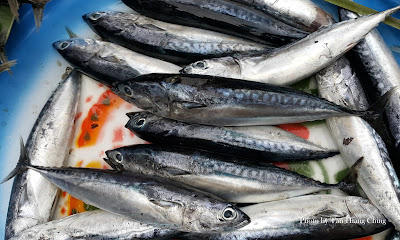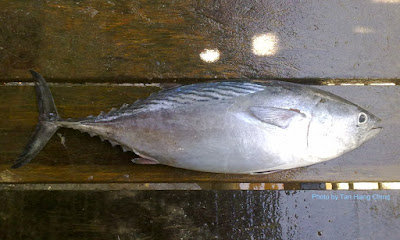Scombrids (Tunas)
Tunas, mackerels, Spanish mackerels, albacore, bonitos, seerfishes and wahoo are the common names for the members of the Scombridae family. The family members are distinguished by having finlets behind their dorsal and anal fins, a deeply forked caudal fin, and at least 2 small keels on each side of caudal peduncle. Many species have a larger keel in between the small keels.
Members of the Scombridae are found in the tropical and subtropical seas around the world. There are 15 genera and 54 species worldwide. All of them are excellent food fishes. Many are of commercial importance and good sports fishes. Scientifically the family is divided into 2 subfamilies. The subfamily Scombrinae consist of 53 species and Gasterochismatinae consist of only one species. However, in general they can be divided according to their shape and behavior into 3 groups; Spanish mackerels, mackerels, and tunas.
Tunas are streamlined fishes, stout in the middle and then tapering to points at both ends. They are known fast swimmers and mostly found near the surface of coastal waters. They frequently occur in small schools and most of them are migratory fishes following a yearly cycle. They are carnivorous, feeding commonly on other schooling fishes, crustaceans and squids.
Members of the Scombridae are found in the tropical and subtropical seas around the world. There are 15 genera and 54 species worldwide. All of them are excellent food fishes. Many are of commercial importance and good sports fishes. Scientifically the family is divided into 2 subfamilies. The subfamily Scombrinae consist of 53 species and Gasterochismatinae consist of only one species. However, in general they can be divided according to their shape and behavior into 3 groups; Spanish mackerels, mackerels, and tunas.
Tunas are streamlined fishes, stout in the middle and then tapering to points at both ends. They are known fast swimmers and mostly found near the surface of coastal waters. They frequently occur in small schools and most of them are migratory fishes following a yearly cycle. They are carnivorous, feeding commonly on other schooling fishes, crustaceans and squids.
Scientific Name: Auxis rochei (Risso, 1810)
English Name: Bullet Tuna, Long Corseletted Frigate Mackerel
Chinese Name | 鱼类中文名: 圆花鲣 (Yuán huā jiān), 柴鱼 (Chái yú), 金鎗魚 (Jīnqiāngyú), 鲔鱼 (Wěi yú)
Malay Name | Nama Melayu Malaysia: Ikan Tongkol, Kayu, Bakulan, Aya Peluru
Thai Name | ชื่อสามัญภาษาไทย: ปลาโอหลอด (Plā xo h̄lxd)
Local Hokkien: Cha Hu
Main Identification Features: Corselet under second dorsal-fin origin more than 6 scales wide. Scaleless area with pattern of 15 or more fairly broad, nearly vertical dark bars.
Size: Maximum fork length 40.0 cm, commonly to 35 cm.
Habitat and Ecology: Pelagic and oceanodromous, to 200 m depth. Form schools. Feed on whatever abundant resource is available with a preference for planktonic crustaceans, small cephalopods, and fish larvae.

Scientific Name: Euthynnus affinis (Cantor, 1849)
English Name: Easten Little Tuna, Kawakawa
Chinese Name | 鱼类中文名: 巴鲣 (Bā jiān), 柴鱼 (Chái yú), 金鎗魚 (Jīnqiāngyú), 鲔鱼 (Wěi yú)
Malay Name | Nama Melayu Malaysia: Ikan Tongkol, Kayu, Bakulan, Aya Kurik
Thai Name | ชื่อสามัญภาษาไทย: ปลาโอลาย (Plā xo lāy)
Local Hokkien: Cha Hu
Main Identification Features: Posterior portion of the back with a pattern of broken oblique stripes. Dorsal fins close together. 2 flaps (interpelvic process) between pelvic fins (not shown). Several characteristic dark spots between pelvic and pectoral fins which may not always be present.
Size: Maximum fork length 100.0 cm, commonly to 60.0 cm.
Habitat and Ecology: Pelagic and oceanodromous, to 50 m depth. Form large schools, including with other species of the same size. Feed on schooling fishes, squids, crustaceans and zooplankton. Percentage of fishes as diet increases with the size of fish.

Scientific Name: Thunnus tonggol (Bleeker, 1851)
English Name: Longtail Tuna
Chinese Name | 鱼类中文名: 青甘金枪鱼 (Qīng gān jīnqiāngyú), 白肉金鎗魚 (Báiròu jīnqiāngyú), 鲔鱼 (Wěi yú), 长腰鲔 (Zhǎng yāo wěi), 小黃鰭鮪 (Xiǎo huángqíwěi)
Malay Name | Nama Melayu Malaysia: Ikan Tongkol, Aya Hitam, Tongkol Abu-abu, Tongkol Hitam
Thai Name | ชื่อสามัญภาษาไทย: ปลาโอดำ (Plā xo dam), ปลาโอหม้อ (Plā xo mo)
Local Hokkien: Cha Hu
Main Identification Features: A small tuna species. First and second dorsal fins close together separated only by a narrow interspace. Second dorsal fin is higher than the first dorsal fin. Pectoral fins are moderately long. Upper body black or bluish black, without stripes. Lower sides and belly silvery white with colourless elongated oval spots arranged in horizontally oriented rows. Dorsal, pectoral and pelvic fins blackish. Anal fin silvery. Tip of the second dorsal and anal fins are washed with yellow. Caudal fin blackish, with streaks of yellowish green. Finlets yellow with greyish margins.
Size: Maximum fork length 130 cm, commonly to 70 cm. Mature at about 40 cm fork length.
Habitat and Ecology: Inshore pelagic but avoids very turbid waters and low salinity areas near mouths of large rivers. Form schools of varying size. Feeds on a wide variety of fishes, cephalopods, and crustaceans, particularly stomatopod larvae and prawns.

English Name: Bullet Tuna, Long Corseletted Frigate Mackerel
Chinese Name | 鱼类中文名: 圆花鲣 (Yuán huā jiān), 柴鱼 (Chái yú), 金鎗魚 (Jīnqiāngyú), 鲔鱼 (Wěi yú)
Malay Name | Nama Melayu Malaysia: Ikan Tongkol, Kayu, Bakulan, Aya Peluru
Thai Name | ชื่อสามัญภาษาไทย: ปลาโอหลอด (Plā xo h̄lxd)
Local Hokkien: Cha Hu
Main Identification Features: Corselet under second dorsal-fin origin more than 6 scales wide. Scaleless area with pattern of 15 or more fairly broad, nearly vertical dark bars.
Size: Maximum fork length 40.0 cm, commonly to 35 cm.
Habitat and Ecology: Pelagic and oceanodromous, to 200 m depth. Form schools. Feed on whatever abundant resource is available with a preference for planktonic crustaceans, small cephalopods, and fish larvae.

Scientific Name: Euthynnus affinis (Cantor, 1849)
English Name: Easten Little Tuna, Kawakawa
Chinese Name | 鱼类中文名: 巴鲣 (Bā jiān), 柴鱼 (Chái yú), 金鎗魚 (Jīnqiāngyú), 鲔鱼 (Wěi yú)
Malay Name | Nama Melayu Malaysia: Ikan Tongkol, Kayu, Bakulan, Aya Kurik
Thai Name | ชื่อสามัญภาษาไทย: ปลาโอลาย (Plā xo lāy)
Local Hokkien: Cha Hu
Main Identification Features: Posterior portion of the back with a pattern of broken oblique stripes. Dorsal fins close together. 2 flaps (interpelvic process) between pelvic fins (not shown). Several characteristic dark spots between pelvic and pectoral fins which may not always be present.
Size: Maximum fork length 100.0 cm, commonly to 60.0 cm.
Habitat and Ecology: Pelagic and oceanodromous, to 50 m depth. Form large schools, including with other species of the same size. Feed on schooling fishes, squids, crustaceans and zooplankton. Percentage of fishes as diet increases with the size of fish.

Scientific Name: Thunnus tonggol (Bleeker, 1851)
English Name: Longtail Tuna
Chinese Name | 鱼类中文名: 青甘金枪鱼 (Qīng gān jīnqiāngyú), 白肉金鎗魚 (Báiròu jīnqiāngyú), 鲔鱼 (Wěi yú), 长腰鲔 (Zhǎng yāo wěi), 小黃鰭鮪 (Xiǎo huángqíwěi)
Malay Name | Nama Melayu Malaysia: Ikan Tongkol, Aya Hitam, Tongkol Abu-abu, Tongkol Hitam
Thai Name | ชื่อสามัญภาษาไทย: ปลาโอดำ (Plā xo dam), ปลาโอหม้อ (Plā xo mo)
Local Hokkien: Cha Hu
Main Identification Features: A small tuna species. First and second dorsal fins close together separated only by a narrow interspace. Second dorsal fin is higher than the first dorsal fin. Pectoral fins are moderately long. Upper body black or bluish black, without stripes. Lower sides and belly silvery white with colourless elongated oval spots arranged in horizontally oriented rows. Dorsal, pectoral and pelvic fins blackish. Anal fin silvery. Tip of the second dorsal and anal fins are washed with yellow. Caudal fin blackish, with streaks of yellowish green. Finlets yellow with greyish margins.
Size: Maximum fork length 130 cm, commonly to 70 cm. Mature at about 40 cm fork length.
Habitat and Ecology: Inshore pelagic but avoids very turbid waters and low salinity areas near mouths of large rivers. Form schools of varying size. Feeds on a wide variety of fishes, cephalopods, and crustaceans, particularly stomatopod larvae and prawns.
